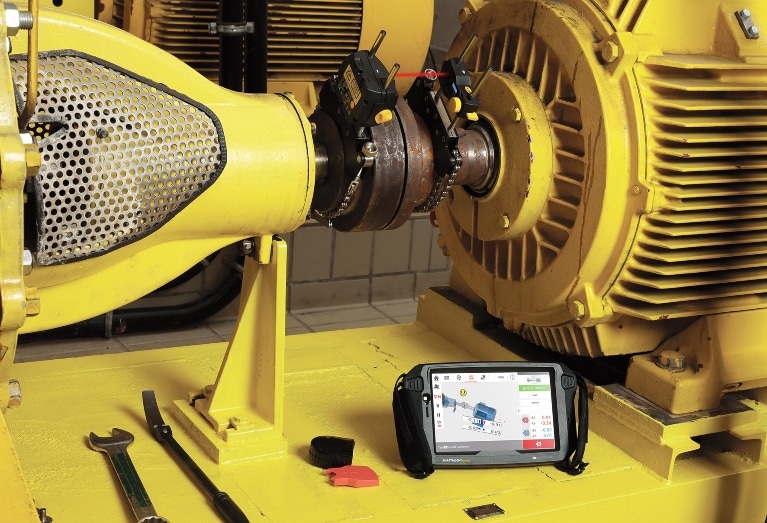
But all laser alignment systems are not equal. Some enable a maintenance team to complete jobs faster and with higher precision, while others require rework and sometimes guesswork that drive maintenance costs higher and possibly compromise the result.
What should you consider when deciding on a laser shaft alignment system? Here are the top five questions to ask:
Does the system require a dual-laser setup, or does it have single-laser technology?
Why this question matters: A system with a dual-laser setup requires you to adjust two lasers and two sensors, which requires more time and effort and introduces more variables.
Additionally, dual-laser systems cannot handle gross misalignments because during the measurement rotation, the laser beam moves off of the detector, and the measurement cannot be completed.
Adaptive Alignment systems with single-laser technology have a “Freeze Frame Measurement” capability. This enables measurements to be completed even when halted partway because of the amount of misalignment, then restarted, eliminating guesswork and saving time.
Does the system’s user manual ever recommend a “rough alignment” or “pre-alignment?”
Why this question matters: Systems that recommend—or require—a rough alignment cost more to operate because they demand more moves—the most time-consuming part of any alignment job. The “as found” condition is lost, and technicians have already made one move before they can even take a measurement.
Does the system provide visual quality factor assessment feedback to the technician in real-time as the measurement is underway, or only after the measurement is finished?
Why this question matters: Getting feedback while doing a job is a better learning experience, and it saves time. It’s important to look for an Adaptive Alignment system that offers the innovation of real-time visual feedback.
During a measurement, the user gets a quick color indicator for easy, intuitive feedback. Green indicates a good quality measurement, while blue indicates an excellent quality measurement. Even the most inexperienced users can quickly learn exactly how to take a quality measurement thanks to this feature.
Can a technician send measurements instantly from the point of work to colleagues elsewhere in the plant (or around the world) to consult on the next steps?
Why this question matters: Two brains are often better than one.
You may have an alignment expert on your team, but he or she cannot get to every machine in every plant. But experts can evaluate and qualify measurement data remotely—if they have access to it—and render assistance from wherever they are.
Systems without collaboration capabilities essentially cut the technician off from help, which is a major factor behind variable alignment quality. Results with these systems are of course better when performed by an expert, but can potentially be unreliable when a less experienced technician completes a job unaided.
Getting a system with collaboration built-in is a great way to unlock overall team capacity—and to ensure that even the least experienced users on a team learn from expert guidance and get high-precision results.
Does the system automatically handle uncoupled shafts without requiring manual efforts to position shafts at the correct relative angle?
Why this question matters: For assets to perform at their peak, they must be installed with care from day one.
During installation, the alignment should ideally be done with uncoupled shafts to eliminate any residual forces within the machine train. But working with uncoupled shafts is not something basic laser alignment systems can easily handle. Technicians have to resort to manual positioning to approximate the correct relative rotational angle.
In contrast, Adaptive Alignment systems, bolstered by Active Situational Intelligence (ASI), have Uncoupled Shaft Awareness. This allows for uncoupled shafts to be in any rotational position—or freely rotating—so long as the single laser hits the single sensor. The adaptive system determines the relative rotational angular positions and calculates the measurement points. With this capability, teams can achieve accurate results quickly.
– – – – –
These five questions pinpoint potential red flags when considering a new laser alignment system. When laser alignment was first invented, none of them could be answered well because adaptive capabilities did not exist. Today’s capabilities require these updated questions.
Adaptive Alignment is the newest generation of laser shaft alignment. Only PRUFTECHNIK has it, and all of these advanced capabilities—which we developed by listening to our customers and focusing relentlessly on real innovation to deliver the best possible results on their rotating machinery. With more than 35 years of experience and innovation in laser shaft alignment, PRUFTECHNIK is prepared to answer any questions your maintenance team may have as you look to invest in a system that enables fast and accurate measurement. For more information, download our white paper on Adaptive Alignment technology.
Related articles:
https://blog.pruftechnik.com/what-it-takes-to-be-the-world-leader-in-machinery-alignment/
